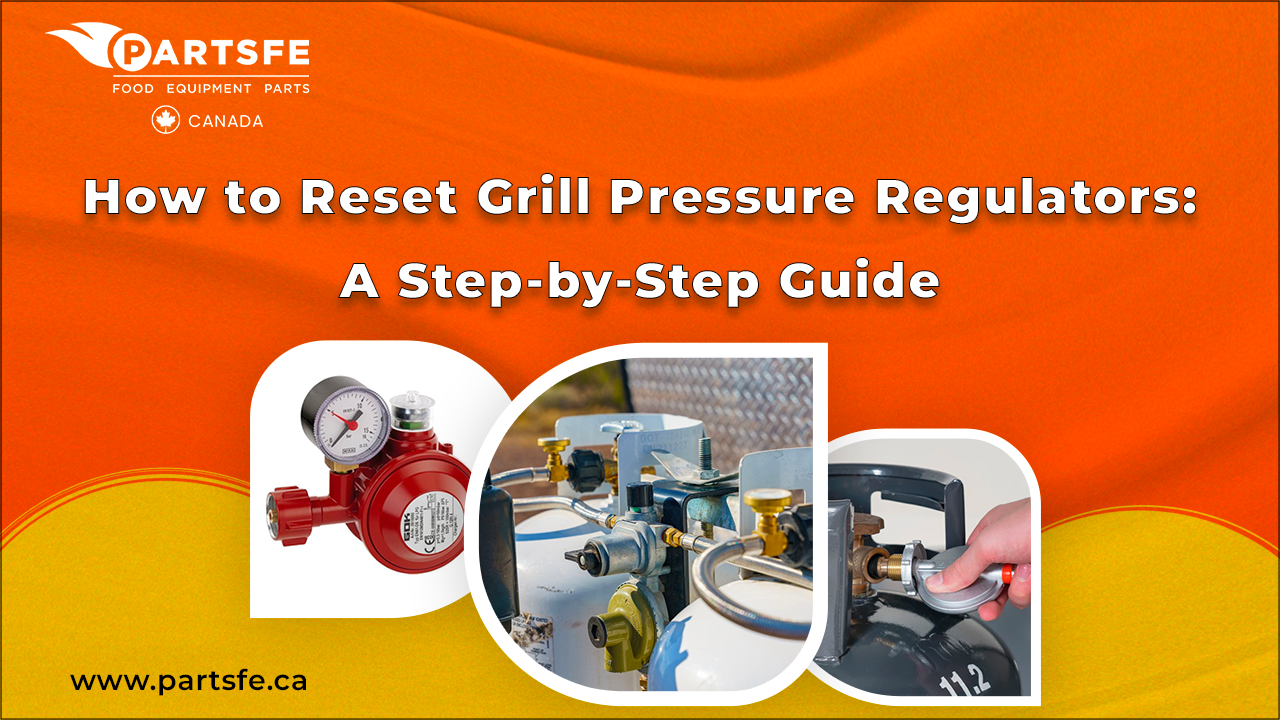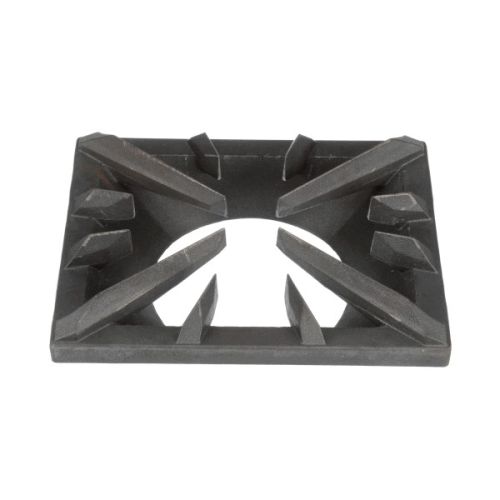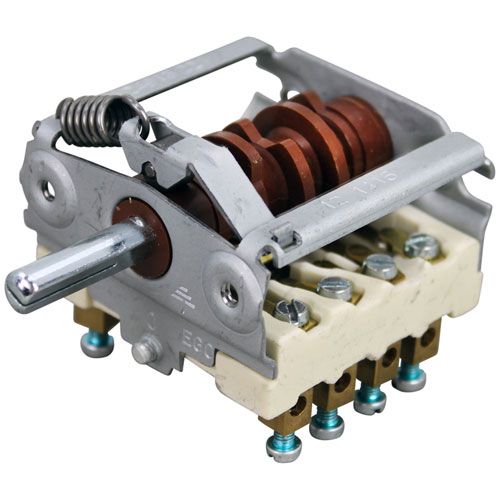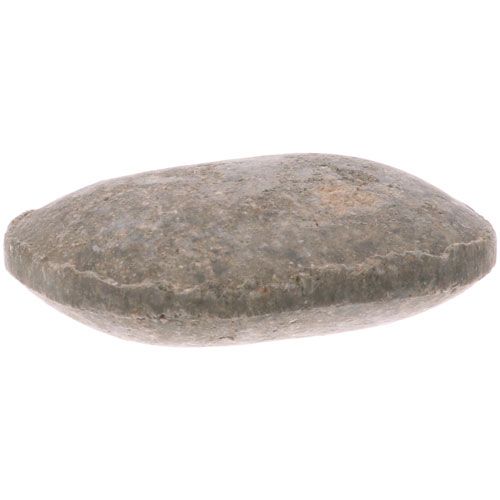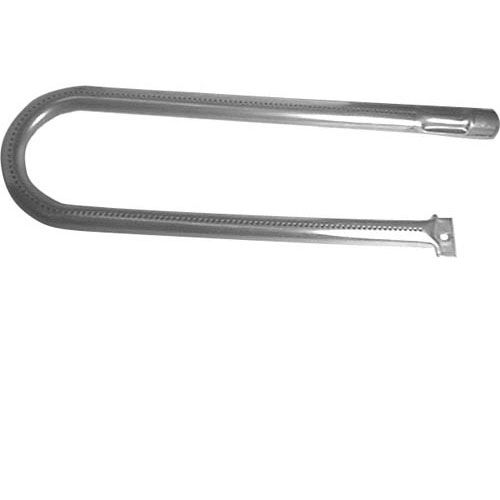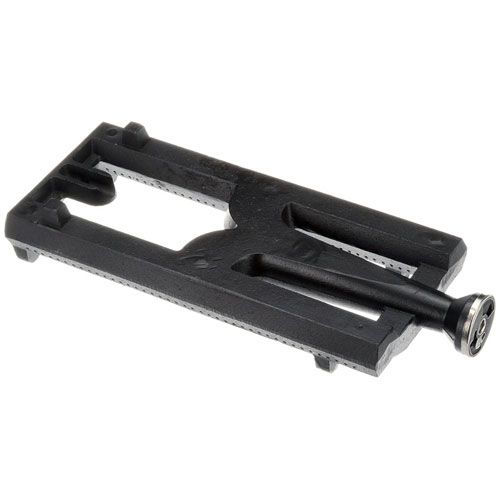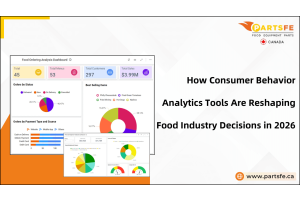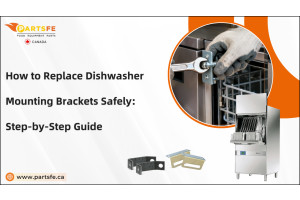How to Reset Grill Pressure Regulators: A Step-by-Step Guide
Is the grill not heating up like it used to? One common reason is a faulty or stuck pressure regulator. The pressure regulator on your gas grill controls the flow of propane or natural gas from the tank to the burners. Over time, it can become locked in a low-flow mode, especially after sudden changes in gas flow, like turning the tank on too quickly. Fortunately, resetting your grill's pressure regulator is a simple task that can restore proper performance without the need for professional help. Whether you're grilling seasoned steaks or weekend burgers, ensuring the right gas pressure is key. In this guide, we’ll walk you through a quick, step-by-step process to reset your grill’s pressure regulator safely and effectively. Let’s get grilling again!
What is a Grill Pressure Regulator and Why is it Important?
Every gas grill requires a grill pressure regulator as its essential component. The pressure regulator maintains a constant and secure gas flow between your propane or natural gas tank and burners. A steady gas flow through your grill enables it to maintain proper temperature levels, which results in uniform cooking of your food. Weak flames and uneven heating and ignition problems can indicate that your pressure regulator needs attention. The warning signs indicate pressure problems that should be resolved before your upcoming cookout.
The pressure regulator serves two essential functions for grill safety in addition to its performance duties. The pressure regulator functions as a protective mechanism that stops dangerous gas flow that could result in dangerous flare-ups or leaks. The majority of contemporary regulators include a safety mechanism named "bypass mode" to shut off gas when problems occur. The safety feature of this device exists to protect users, but it may trigger unintentionally when users open the tank valve rapidly. A basic reset procedure will return normal operation in these situations. Concerning your outdoor cooking safety and grill performance, you must grasp the basic functions of your pressure regulator system.
Looking for reliable grill parts? At PartsFe CA, we offer top-quality products to keep your grill in perfect condition. Explore our range of replacement knobs, gas regulators, flame sensors, burner tubes, and propane hoses from trusted brands like Garland, Blodgett, Vulcan, and Frymaster to enhance your grilling experience!
Common Symptoms of a Faulty Grill Pressure Regulator
Your grilling experience will suffer from various problems when your grill pressure regulator fails. Early symptom recognition enables you to decide between a reset or a replacement of your grill. Here are some common signs:
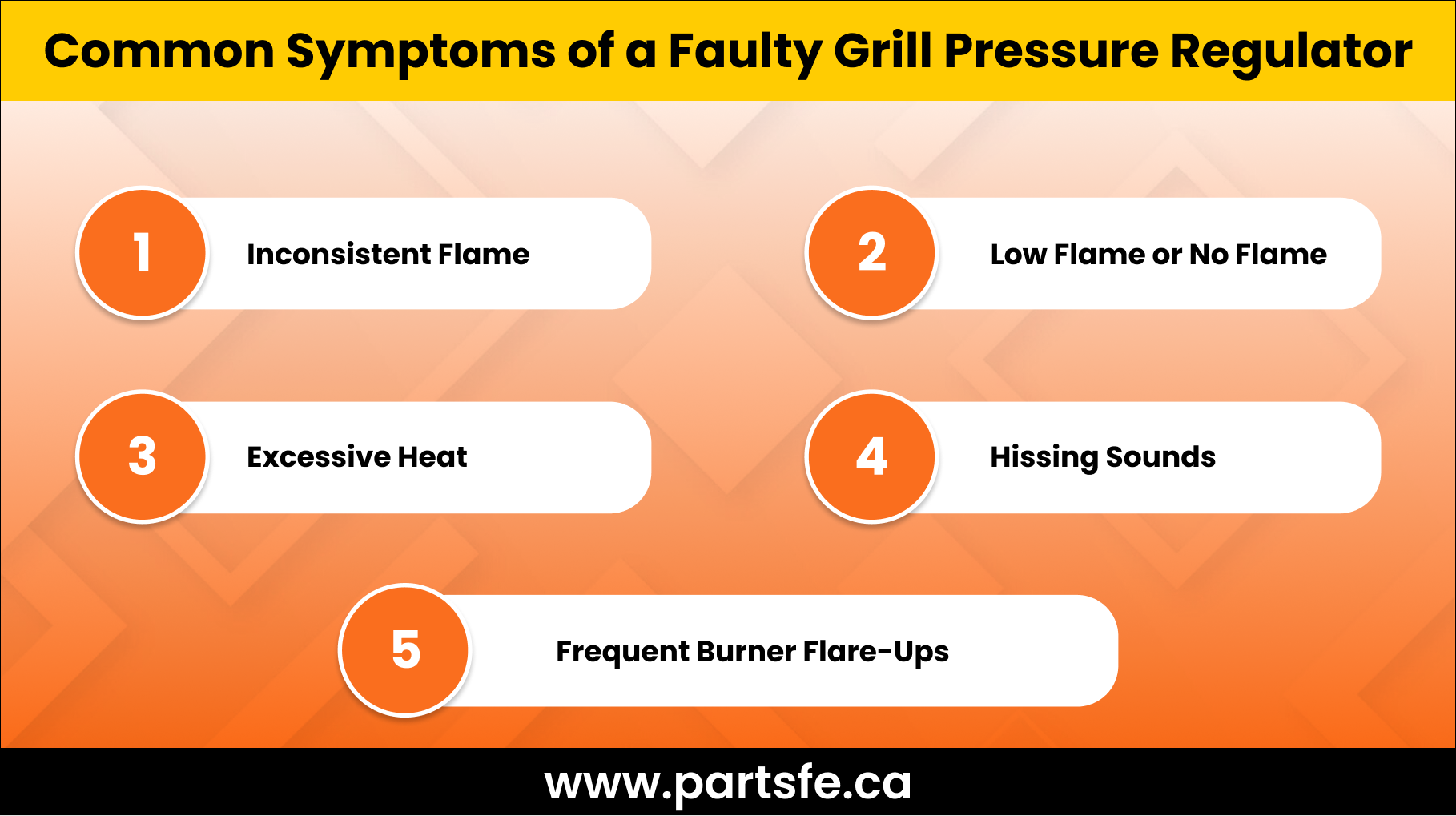
-
Inconsistent Flame: A pressure regulator malfunction may be indicated by a grill flame that alternates between high and low or fails to maintain stability. The proper functioning of a regulator depends on maintaining a steady flame because an unstable gas flow leads to uneven cooking.
-
Low Flame or No Flame: A failing pressure regulator becomes apparent through either a weak or absent flame. The gas flow becomes unmanageable or the regulator becomes clogged, which leads to this issue.
-
Excessive Heat: An intense flame that burns too hot or an excessively intense flame indicates pressure problems, which create unsafe conditions during grilling.
-
Frequent Burner Flare-Ups: A faulty regulator will generate unexpected burner flare-ups and cause uneven heat distribution of the burners through its ineffective control of gas flow.
-
Hissing Sounds: A hissing noise near the regulator indicates either a gas leak or a malfunctioning regulator that fails to regulate pressure correctly.
These symptoms signal that you should inspect your grill regulator for possible resetting.
Tools You’ll Need to Reset the Grill Pressure Regulator
You need to obtain essential tools before starting the grill pressure regulator reset process. The process of resetting a regulator remains simple and does not need special tools for completion. Here’s what you’ll need:
-
Adjustable Wrench: The adjustable wrench enables you to make and break connections between the tank, regulator and hose.
-
Soap and Water Solution: A solution of soap and water enables leak detection through bubble formation after the regulator reset.
-
Rag or Cloth: The rag or cloth serves to clean connections by removing dirt and debris.
-
Gloves: Put on gloves prior to touching any part of the propane tank and its regulator system.
-
Flashlight: The tool provides sufficient illumination to check connections in poorly lit areas.
-
Pipe Tape: The threads on connections require pipe tape for sealing purposes to prevent gas leaks when rebuilding the system.
-
Pressure Gauge: The pressure gauge serves as a tool to check gas pressure levels after resetting for proper regulator function.
-
Channel Lock Pliers: Channel Lock Pliers deliver additional force to remove fittings that resist normal loosening methods from regulator and hose components.
-
Gas Leak Detector: The gas leak detector operates better than traditional soap-and-water methods to provide enhanced safety for detecting leaks.
-
Hose Brush: A hose brush serves as an excellent tool to clean gas grill hoses, which helps prevent obstructions from disrupting gas flow.
Check out these effective ways to clean your grill grates to keep your grill grates or burners running smoothly.
Troubleshooting Common Issues During Grill Pressure Regulators Process
Resetting your grill's pressure regulator can resolve common issues, but sometimes, problems persist. This guide will walk you through step-by-step troubleshooting to fix those issues quickly and safely.
Regulator Won't Reset
The regulator system fails to reset, thus blocking proper gas flow through the system.
Solution: Check that the gas tank valve remains fully closed before waiting for several minutes before reopening it slowly. Open the tank valve after waiting for several minutes, doing it gradually. Check the regulator for damage before deciding to replace it.
Weak or Flickering Flames
A gas flow problem exists when the flames appear weak or unstable.
Solution: A weak flame signals either a loose connection or insufficient gas flow. Check that both the tank and grill connections have a secure attachment to the regulator. Check that the gas hose remains free from both kinks and blockages. Check the connections again before performing another reset.
Grill Won’t Ignite
The grill fails to light up because the regulator operates in bypass mode.
Solution: Your grill fails to ignite when the regulator remains in bypass mode. Open the tank valve gradually after waiting for several minutes while the gas remains off. Check the ignition system for any potential blockages or dirt that might stop the spark from occurring.
Gas Leaks After Reset
The proper tightening of connections prevents gas leaks from happening.
Solution: Check for gas leaks after you reset the regulator as a standard procedure. Use a soapy water mixture to check all connection points. Check the connections again after applying pressure to the bubbles that appear until the system shows no signs of leakage.
Can't Remove Regulator Hose from Grill
The regulator hose remains firmly attached to both the tank and the grill unit.
Solution: An adjustable wrench should be used to gently loosen the regulator hose when you cannot remove it. Apply penetrating oil to the stuck regulator due to corrosion then wait a few minutes before your next attempt. Handle the hose and connections with care to prevent any damage.
Adjustable Propane Regulator for a Grill Not Working Properly
The adjustable propane regulator produces unexpected results, which leads to either minimal or zero pressure output.
Solution: Check the adjustment valve on your adjustable propane regulator to determine if it is set correctly when it fails to work properly. The regulator should be replaced if it fails to function properly. Open the gas tank valve at a slow pace to prevent bypass mode activation.
Changing Regulator on Gas Grill
It becomes difficult to replace the regulator when connections are either tight or stuck.
Solution: Begin by turning off the gas supply, then disconnect the old regulator with a wrench. Securely install the new regulator by tightening all connections. Test the system for leaks using soapy water after installation and check for proper function before using the grill for cooking.
The reset process includes systematic solutions for common gas grill pressure regulator problems that guarantee the safe and efficient operation of your grill.
Safety Tips and Precautions When Resetting Your Grill Pressure Regulator
Safety must be your main concern when you reset your grill pressure regulator. These essential safety measures and precautions will help you perform a successful reset of your grill pressure regulator:
-
Turn Off the Gas: Begin your reset process by disconnecting the propane tank gas supply. Working on the regulator becomes safer because you prevent gas from escaping through the proper shutdown of the gas supply.
-
Work in a Well-Ventilated Area: Reset your grill pressure regulator in an open space or well-ventilated area to avoid gas accumulation inside a confined area. The procedure decreases the potential for dangerous fires and dangerous fume inhalation.
-
Check for Leaks: A soap-and-water solution should be used to check for leaks at all connections after the regulator reset. Bubbles appearing during the inspection indicate a leak that requires urgent attention before operating the grill.
-
Avoid Open Flames: Working near open flames or heat sources is strictly prohibited when you reset the regulator. Gas possesses flammable properties so tiny electrical sparks can easily start a fire.
-
Use Proper Tools: Stick to using the tools specified by the manufacturer to protect both the regulator and other components from damage. The use of improper tools results in faulty connections that can cause gas leakage.
-
Inspect for Wear and Tear: A thorough inspection of the regulator along with hoses and connections must occur before resetting to check for any signs of wear or damage. Replace any compromised parts to stop additional problems from occurring.
These safe steps allow you to reset your grill’s pressure regulator successfully while ensuring protection.
How to Reset Grill Pressure Regulators?
A basic procedure exists to reset your grill pressure regulator, which helps resolve performance problems such as unstable flames or weak heat output. Here’s how to do it:
-
Turn Off the Gas: Begin by shutting off the gas supply from the tank. Turn off both the propane tank valve and the grill’s burner knobs to stop gas from leaking out.
-
Disconnect the Regulator: A wrench with adjustable jaws should be used to detach the regulator from its position on the propane tank. Clean all connections thoroughly before reattaching them.
-
Reset the Regulator: You must manually reset the safety feature or press the reset button that exists on most pressure regulators. You should activate the reset valve (if present) on the regulator by pressing or twisting it. The regulators require temporary disconnection followed by a few minutes of rest before reconnection.
-
Reattach the Regulator: Securely attach the regulator to the propane tank by following the correct connection procedure. Secure the regulator connection with your adjustable wrench while avoiding excessive force.
-
Check for Leaks: Create a mixture of dish soap and water in a spray bottle. Apply the solution to both the regulator and its connections. Bubbles appearing during this test indicate a leak that requires immediate attention.
-
Turn On the Gas: Turn on the gas at the tank slowly while checking if the pressure regulator works correctly by lighting the grill.
Your grill will be ready for safe cooking after completing these steps.
-
Use Proper Tools: Use only the tools specified by the manufacturer to protect both the regulator and other components from damage. Using improper tools can result in faulty connections, which may produce gas leaks.
-
Inspect for Wear and Tear: A thorough inspection of the regulator and hoses and connections should be performed before resetting to check for any signs of wear or damage or cracks. Replace damaged parts before continuing to avoid additional problems.
The safety guidelines enable you to reset your grill's pressure regulator properly so you can enjoy a secure and seamless grilling session.
Preventive Maintenance Tips for Grill Pressure Regulators
Regular maintenance of your grill pressure regulator through proper care will both increase its lifespan and maintain its consistent operation. These steps will help you maintain your regulator at its best performance level:
-
Regularly Check for Leaks: Regular inspections should be conducted on the regulator and gas hose and propane tank connections to check for any leaks. A solution of soap and water can be used to detect bubbles. Check for leaks immediately because they pose safety risks that need immediate attention.
-
Keep the Regulator Clean: The gas flow becomes affected when dirt and debris block either the regulator or the gas lines. Regular cleaning of the regulator and its surrounding components requires a clean cloth. Check that all vents on the regulator remain unblocked.
-
Inspect Hoses for Wear: Check the gas hose for any signs of cracking or wear or brittleness. A hose with damage will create gas leaks while simultaneously reducing the system's operational efficiency. Any detected damage to the hose requires immediate replacement.
-
Store Properly: When storing your grill for the off-season, you should place the regulator and propane tank in a dry area with cool temperatures that stays away from extreme heat. Extreme temperatures affect how well the regulator functions.
-
Tighten Connections: Regularly inspect the secureness of all connections between the regulator and the hose and tank. Flame irregularities and gas leaks occur when connections between components are loose.
-
Test the Regulator Annually: Check the regulator performance once per year by starting the grill and watching the flame. A weak or inconsistent flame indicates that you should reset or replace the regulator.
Through basic maintenance practices, you can prevent malfunctioning of your pressure regulator while achieving safe and efficient grilling throughout multiple years.
Check out this ultimate guide to seasoning cast-iron grill grates to maintain performance and prevent rust. Keeping other components like grill grates in top condition.
Grill pressure regulator reset procedures deliver quick results for optimal performance alongside the prevention of unsafe conditions during barbecuing. A simple reset procedure solves most gas grill pressure regulator issues, which manifest as low flames and uneven heating and ignition problems. Learning about regulator operation combined with identifying standard problems and performing correct procedures enables you to solve these issues and restore your grill's maximum power output.
The lifespan of your gas grill pressure regulator can be extended through regular maintenance checks and regulator cleaning and periodic replacements every few years to prevent future problems. The described steps enable you to achieve uniform barbecuing outcomes for both major family cookouts along weekend outdoor grilling sessions. A properly maintained grill ensures that perfect flames remain accessible with a simple turn of the knob.
FAQ’S
What is the pressure of a gas grill regulator?
An average gas grill regulator provides a pressure of 11 inches of water column (approximately 0.4 PSI). This provides a consistent and safe gas flow to the burners for proper heat.
Do I need a regulator for my propane grill?
Yes, there is a regulator to bring down high tank pressure to a usable level. Otherwise, gas flow can be unsafe and will harm your grill.
How often do you need to replace the regulator on a gas grill?
Regulators should routinely be replaced every 3 to 5 years based on use and exposure. Indications such as weak flames, leaks, or bad ignition can call for earlier replacement.
How to reset pressure regulator on gas grill?
Switch off the burners and propane tank and then remove the regulator and wait for 5–10 minutes. Restore everything and carefully open the tank valve in order to reset it.

